Nanocellulose from Algae Promising for Manufacturing, Medicine, Environment
 Print this article | Send to Colleague Print this article | Send to Colleague
 U.S. scientists this week announced a new, groundbreaking method for producing nanocellulose that could be used to create ultra-thin displays, lightweight body armor, and a wide range of other products. According to a report by The Verge, New York, N.Y., USA, the key ingredient is algae. U.S. scientists this week announced a new, groundbreaking method for producing nanocellulose that could be used to create ultra-thin displays, lightweight body armor, and a wide range of other products. According to a report by The Verge, New York, N.Y., USA, the key ingredient is algae.
As the report explains, Dr. R. Malcolm Brown, a biology professor at the University of Texas at Austin, presented his team's findings at an American Chemical Society conference in New Orleans this past Sunday, heralding their progress as a major step toward "one of the most important discoveries in plant biology." At the core of Brown's research is a family of bacteria that produce vinegar, Kombucha tea, and nata de coco. These bacteria secrete nanocellulose in a culture medium, though extracting the material at a large scale would require high volumes of sugars, nutrients, and fermentation tanks. Today, most non-bacterial nanocellulose is produced from compressed and homogenized wood pulp — a relatively inexpensive, but resource-heavy process.
Brown's method, The Verge report explains, is much more efficient and environmentally friendly, requiring only sunlight, water, and algae. By genetically engineering vinegar bacterium into blue-green algae, Brown's lab has effectively created organic factories capable of making nanocellulose on a potentially industrial scale. These genetically-altered algae, known as cyanobacteria, are entirely self-sustaining. They produce their own food from sunlight and water, and absorb carbon dioxide from the atmosphere, offering a natural way to reduce the world's most pernicious greenhouse gas.
Brown says bacterial nanocellulose also can be used to create ballistic glass, aerospace materials, or even wound dressings, due to the fact that it retains its stiffness and strength even when submerged in liquid. But perhaps its most obvious application would be in the paper and display industry. At a press briefing Sunday, Brown said he and his team have begun adding electrochromic dye to the cellulose to create an electronic display. "I see this as a major development," he said, noting that its thin and flexible qualities make it ideal for electronic wallpaper, as well.
Brown's lab is still "five to ten years" away from adapting the process to a large scale, though he says the science behind it is sound. All they need now, the professor explains, is broader awareness and momentum.
Last year, the US Forest Service opened the country's first nanocellulose production facility in Wisconsin. After devoting 40 years to nanocellulose research, Brown hopes that his latest developments will encourage similar investments, The Verge notes.
|
|

